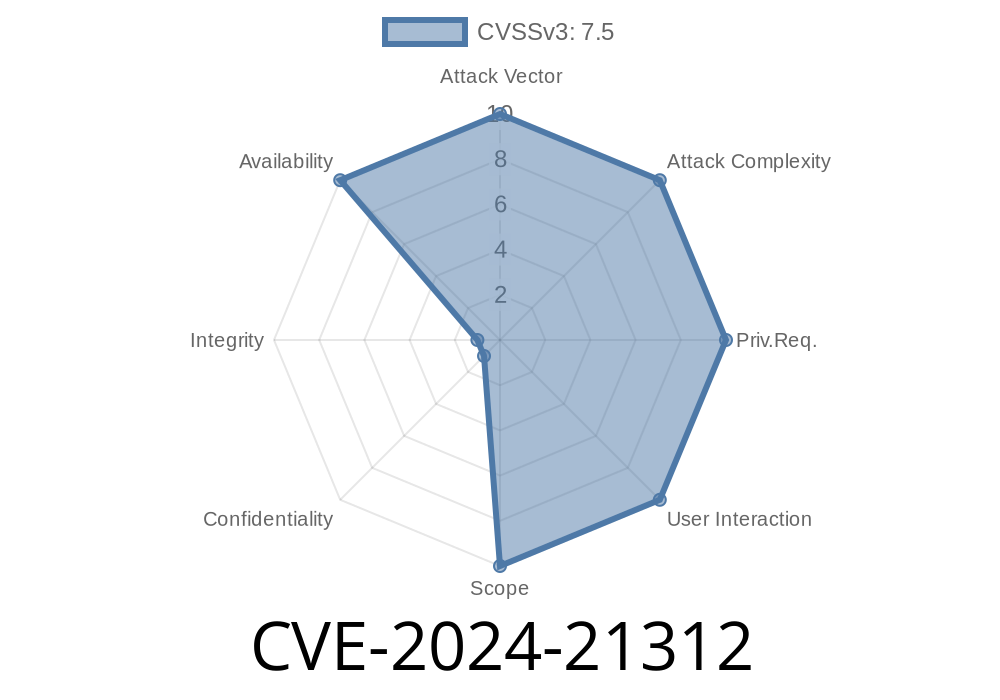On the horizon of newly discovered cybersecurity vulnerabilities stands CVE-2024-21312, a recent flaw uncovered in the Microsoft .NET Framework, allowing for devastating Denial of Service (DoS) attacks. As we all rely heavily on the stability and security of the .NET Framework, it is crucial to protect our applications and services from potential exploits.
In this long read, we will dissect CVE-2024-21312 and investigate the impact it can have on an organization's infrastructure. We'll explore real-world code snippets, identify the root cause of the issue, and discuss possible mitigation techniques. We will also provide links to reputable sources for further reading and understanding.
Background
CVE-2024-21312 was first introduced in the National Vulnerability Database (NVD) and later analyzed in detail by cybersecurity experts. The vulnerability originates from a deficiency in the .NET Framework XML processing, allowing a malicious user to exploit it by sending deliberately crafted XML data to an application. Consequently, the application becomes unresponsive or crashes, leading to a DoS.
You can read the original CVE report here: NVD - CVE-2024-21312
A real-world exploitation example
To truly understand the vulnerability, it helps to examine a practical example. An application using the .NET Framework XML parser to process incoming XML data could fall victim to CVE-2024-21312 through a simple, yet malicious, XML file:
<?xml version="1."?>
<!DOCTYPE exploit SYSTEM "http://example.com/dos.dtd"; [
<!ENTITY dos ATTACK PAYLOAD>
]>
<exploit>&dos;</exploit>
In this example, "ATTACK PAYLOAD" represents malformed or deliberately difficult-to-process data. When the application processes this XML data, it consumes excessive system resources and ultimately results in a DoS.
Why CVE-2024-21312 is dangerous
CVE-2024-21312 is particularly perilous because it can be exploited without any prior authentication or privileges, making it easy for unauthorized individuals to initiate a DoS attack. It also is a critical vulnerability that can be exploited in a wide variety of applications that utilize the .NET Framework XML parser.
Mitigating the risk
There are several steps developers and system administrators can take to protect their environment against CVE-2024-21312:
1. Apply the official patch from Microsoft: Microsoft has released a patch to address the vulnerability. You can find the details and download links from the Microsoft Security Response Center: MSRC - CVE-2024-21312
2. Limit XML input size: By limiting the size of incoming XML data, you can prevent a large-scale exploit attempt.
3. Implement XML schema validation: By validating incoming XML data against a predefined XML schema, you can identify and reject malformed or unexpected XML data.
4. Perform input sanitation and filtering: Remove potentially harmful characters and clean user-supplied input before processing.
Conclusion
CVE-2024-21312, the .NET Framework Denial of Service vulnerability, undoubtedly poses a severe threat to applications and services within your organization. To prepare and protect your systems, it is imperative to understand the exploit, stay informed on updates, and proactively mitigate potential risks.
By being diligent in applying patches, limiting XML data size, validating and sanitizing your XML inputs, you significantly reduce the risk of falling victim to CVE-2024-21312-related DoS attacks. Stay safe and proactive as we continue to navigate the complex and ever-evolving landscape of cybersecurity.
Timeline
Published on: 01/09/2024 18:15:55 UTC
Last modified on: 04/11/2024 20:15:17 UTC
